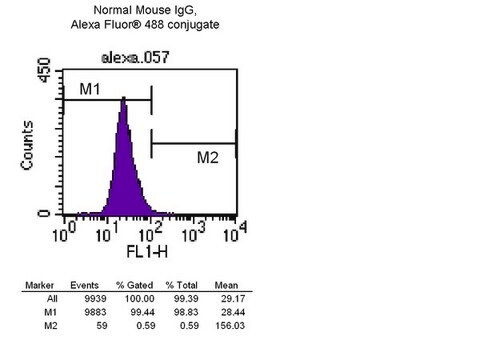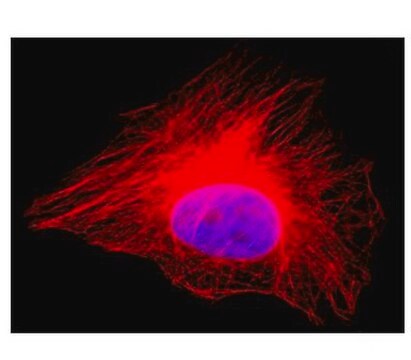05-829-AF647
Anti-α-Tubulin Antibody, clone DM1A, Alexa Fluor™ 647 conjugate
clone DM1A, from mouse, ALEXA FLUOR™ 647
Sinonimo/i:
Tubulin alpha-1 chain, α-Tubulin
About This Item
Prodotti consigliati
Origine biologica
mouse
Livello qualitativo
Coniugato
ALEXA FLUOR™ 647
Forma dell’anticorpo
purified immunoglobulin
Tipo di anticorpo
primary antibodies
Clone
DM1A, monoclonal
Reattività contro le specie
guinea pig, rat, porcine, human, gerbil, mouse, bovine, avian
tecniche
immunocytochemistry: suitable
Isotipo
IgG1
N° accesso NCBI
N° accesso UniProt
Condizioni di spedizione
wet ice
modifica post-traduzionali bersaglio
unmodified
Informazioni sul gene
human ... TUBA1A(7846)
Descrizione generale
Specificità
Immunogeno
Applicazioni
The unconjugated antibody (Cat. No. 05-829) is shown to be suitable also for immunocytochemistry, immunofluorescence, and Western blotting applications.
Cell Structure
Cytoskeleton
Qualità
Immunocytochemistry Analysis: A 1:100 dilution of this antibody detected α-Tubulin in A431 cells.
Descrizione del bersaglio
Stato fisico
Stoccaggio e stabilità
Altre note
Note legali
Esclusione di responsabilità
Non trovi il prodotto giusto?
Prova il nostro Motore di ricerca dei prodotti.
Codice della classe di stoccaggio
12 - Non Combustible Liquids
Classe di pericolosità dell'acqua (WGK)
WGK 2
Punto d’infiammabilità (°F)
Not applicable
Punto d’infiammabilità (°C)
Not applicable
Certificati d'analisi (COA)
Cerca il Certificati d'analisi (COA) digitando il numero di lotto/batch corrispondente. I numeri di lotto o di batch sono stampati sull'etichetta dei prodotti dopo la parola ‘Lotto’ o ‘Batch’.
Possiedi già questo prodotto?
I documenti relativi ai prodotti acquistati recentemente sono disponibili nell’Archivio dei documenti.
Il team dei nostri ricercatori vanta grande esperienza in tutte le aree della ricerca quali Life Science, scienza dei materiali, sintesi chimica, cromatografia, discipline analitiche, ecc..
Contatta l'Assistenza Tecnica.








